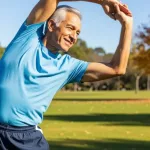
How mobility exercises are important for seniors?
Gaining mobility through targeted exercises can transform seniors' lives by enhancing independence and reducing injury risk, but how exactly does it work?


Yoga is known for transforming the body in ways that go far beyond flexibility. With consistent practice, it strengthens muscles, improves posture, and enhances balance, helping you move with more ease and confidence. But the impact doesn’t stop there. Yoga also supports heart health, boosts joint mobility, and can even ease pain and tension built up from daily life. The result? A body that feels stronger, lighter, and more centered. Discover what really happens when you commit to yoga and how it can reshape your health from the inside out.

Although many forms of exercise contribute to physical fitness, yoga uniquely enhances flexibility and range of motion by systematically stretching and strengthening muscles and joints.
Practicing yoga with proper technique and gradual progression minimizes injury risk. This careful approach allows individuals to safely improve mobility, aiding daily activities and reducing stiffness, while promoting long-term joint health and overall physical comfort.
You might also like to read: Benefits of Yoga
In addition to improving flexibility, yoga plays a significant role in building muscle strength and tone.
Through controlled, weight-bearing poses, it engages various muscle groups safely, promoting endurance and stability.
Consistent practice enhances muscle definition without excessive strain, reducing injury risk.
This balanced strengthening supports overall physical health, making yoga a practical choice for those seeking a safe, effective way to enhance muscular fitness.
When practiced regularly, yoga enhances posture and alignment by strengthening core muscles and increasing body awareness.
This helps individuals maintain proper spinal alignment during daily activities, reducing strain and discomfort.
Gentle, mindful movements encourage safe adjustments, promoting balanced muscle use and preventing poor posture habits.
Consistent practice supports long-term spinal health and overall structural stability.
Numerous studies show that regular yoga practice can considerably enhance cardiovascular health by improving circulation, lowering blood pressure, and reducing heart rate.
Gentle movements and controlled breathing support heart function safely, minimizing strain. Consistent practice may help reduce risks associated with heart disease, promoting overall cardiovascular wellness without intense exertion.
This makes yoga a suitable option for those prioritizing safe, heart-healthy exercise.
Enhancing joint health and mobility, yoga incorporates stretching, strengthening, and controlled movements that maintain flexibility and reduce stiffness.
These gentle exercises support cartilage health and promote synovial fluid circulation, essential for lubrication.
Practicing yoga mindfully helps prevent injury by improving range of motion safely, making it an effective approach for sustaining joint function and overall mobility over time.
Because yoga integrates mindful breathing and meditative practices, it effectively reduces stress levels and promotes relaxation.
These techniques help calm the nervous system, lowering cortisol production and easing tension.
Practicing yoga in a safe, controlled environment allows individuals to unwind gently, fostering mental clarity and emotional balance without strain or risk, supporting overall well-being.
Yoga offers significant improvements in balance and coordination through its emphasis on controlled movements and mindful body awareness.
Practicing poses that require stability strengthens muscles and enhances proprioception, reducing the risk of falls.
This gradual development supports safe progression, making yoga a suitable activity for individuals seeking to improve physical control without overexertion or injury.
Incorporating gentle stretching and controlled breathing techniques can greatly alleviate chronic pain and accelerate recovery from injuries.
Yoga promotes safe muscle relaxation, reduces inflammation, and enhances circulation, supporting healing processes.
Its mindful approach encourages body awareness, helping individuals avoid strain while improving flexibility and strength.
Practicing under professional guidance guarantees safety and maximizes pain management benefits effectively.
Yoga provides extensive physical benefits by enhancing flexibility, strength, and posture while supporting cardiovascular and joint health. Its systematic practice improves balance, coordination, and range of motion, contributing to overall physical wellness. Additionally, yoga’s gentle movements aid in pain management and recovery, making it a valuable holistic approach. Through consistent engagement, individuals can experience improved body function and reduced stress, promoting long-term health and well-being.

Gaining mobility through targeted exercises can transform seniors' lives by enhancing independence and reducing injury risk, but how exactly does it work?

Jumpstart your strength training by syncing workouts with your menstrual cycle—discover the surprising benefits that await when you train with your body’s rhythm.

Get the best techniques to stretch your knee effectively and safely, improving flexibility and preventing injury—discover the key moves you shouldn’t miss.

Learn how stretching before exercise boosts performance and prevents injuries, unlocking benefits you might be missing out on. Discover the key reasons now.

The ultimate guide reveals essential techniques and tips to prevent injuries—discover how simple changes can protect your body and enhance your performance today.

Wondering if stretching after working out is truly mandatory? Discover the surprising benefits and expert insights that might change your routine forever.